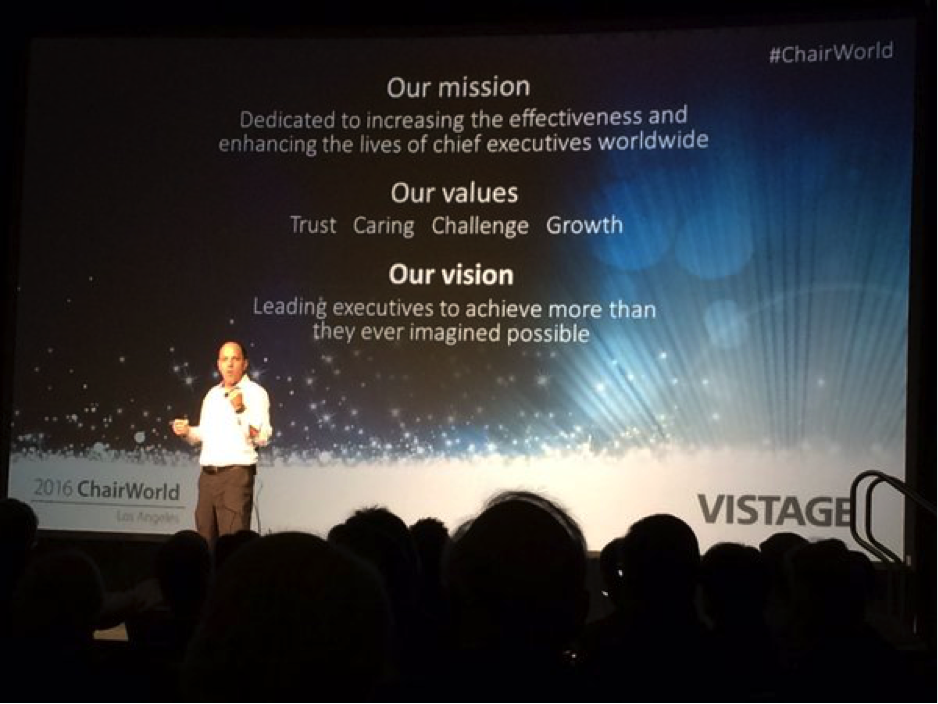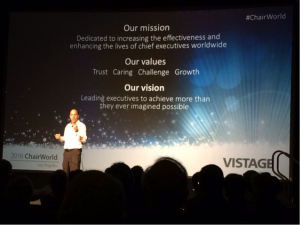Leadership Catalyst Blog

ChairWorld 2016 – Vistage Chairs Gathered in LA to “Sharpen the Saw” Together
Coaching, Human Capital, Leadership Development / 25.02.2016
What am I doing to continuously up my game? This question was top of mind as Vistage CEO Peer Advisory Board Facilitators from around the world gathered in Los Angeles earlier this month for ChairWorld 2016.
As a Vistage Chair and long time CEO coach, I frequently advise and assist my Vistage members and executive coaching clients as they work through stressful business challenges and weigh major decisions with company wide implications. I have the privilege of influencing the few that influence the many. For people like myself who are in the business of giving advice and facilitating issue resolution for a living, it can be easy to forget that even the best coaches and advisors in the field need to actively seek opportunities to up our game and build our knowledge banks so that we can bring more value to our clients and for our own good.
I appreciate that Vistage recognizes the importance of continuously “sharpening the saw” and provides opportunities such as ChairWorld for their professional chairs to do so. This is a key differentiator for Vistage as compared to many other chief executive peer group models.
Over 525 Vistage Chairs from all around the world came together for ChairWorld with the focus on how to improve as leaders and facilitators, learning from each other and fostering a stronger community. There were excellent keynote speakers, numerous breakout sessions to choose from, small-group workshops, formal and informal networking opportunities, and fun social events planned in the evenings.
The highlights of the conference for me included:
- Keynote address on leadership through adversity by polar explorer and top-rated Vistage speaker “Antarctic Mike” Pierce. Mike is the speaker that I have brought in to anchor my 4 Vistage Group meetings this week, and after listening to his talk at ChairWorld I know that my Vistage members are in for a treat.
- Breakout session on putting together a deal team when selling a business, led by legal and financial experts representing the buy and sell sides of transactions. A key question discussed was “how much lead time do you need for an exit” – a topic that I know to be relevant for some of my Vistage members.
- Dinner with the Vistage Colorado chairs – the Denver business climate is similar to Minneapolis in many ways. It was great to get to know the Colorado Vistage team better and to learn more about some of the innovative things that they are doing while also sharing the unique ways that the Minnesota team has been collaborating.
- Leading a “Wisdom Walk” session which paired chairs up to practice 1:1 coaching techniques so that the chairs could learn from each other
- Spending time with Lance Desceurez, the recipient of this year’s Vistage Pope Award which goes to the one chair out of 800 that best exemplifies our values and epitomizes the impact we as chairs strive for Lance is a good friend and mentor, and I know he will continue to help me raise my game as a chair this year.
One of my goals coming into ChairWorld was to look for opportunities around how I can improve my daily and monthly meetings with my members. Specifically, how I can inject more energy into my meetings and go deeper on issue processing to help my Vistage members and coaching clients understand the self-limiting beliefs that are holding them and their businesses back. I was also hoping to expand my Vistage community, increasing the number of chairs who I could pick up the phone and call as a friend, to talk through whatever the latest business issue or ideas we might have.
My experience at ChairWorld 2016 did not disappoint, and I am already applying my new learnings and building on new friendships.
So my question to all of my members and readers is: What are you doing to sharpen your saws? What is your version of Chairworld? Do you have a mentor or coach who is challenging you and helping you to become the best version of yourself. World class athletes have coaches to challenge them and keep them performing at the highest level – why shouldn’t you as a highly successful executive?
Read More >>
BRIC Countries Might Fall Short on Their Vision for Economic Growth
All Blog Posts, Business, Change, Human Capital, Strategy / 05.05.2014
In my last post, I summarized a great presentation from Vistage Speaker Herb Meyer about the dramatic global drop in birthrates and the implications for businesses in this country. In this post, I will be summarizing Herb’s comments and will add my own conclusions on the “BRIC” countries (Brazil, Russia, India, and China) that have often been cited as the emerging markets that will drive the global economy.
Brazil –Brazil is a real bright spot amongst the BRICs in that the country has a healthy birthrate of over 2.1, modernization is accelerating, and the middle class is growing by 10 to 20 million people per year. While you need Portuguese speaking resources to do business in Brazil, it is a great market to go after with existing US products and services tailored to the specific market preferences.
Russia – Russia is in trouble with a low birthrate of 1.4 and a rapidly aging population that lacks young people to replace the economic output of the baby boomers. The average Russian woman has had 6 abortions, which further reduces fertility rates. A couple of years ago, one of Russia’s provinces attempted to address the birth rate problem by declaring September 12th as “The Day of Conception” — closing its businesses at noon so workers could go home and “make another patriot” for Russia. A few years later, September 12th was proclaimed a national holiday called “The Day of Marital Contact. ” So far we haven’t seen a big spike in June birthrates. Russia has a lot of wealth coming from the energy sector, but their overall economy is not particularly diverse. Russia does not have a large growing middle class to whom U.S. products and services can be marketed.
India – India is the country to watch out for. India’s birthrate is 2.8 and significant portions of the population are well educated and speak English. Herb thinks India will blow past China in terms of economic growth because the country has a gigantic middle class society and the next generation will be even larger while China’s will be getting smaller.
India is not without problems. India has a terrible power grid, the roads are bad, and other facets of the country’s infrastructure are poor. India (and China) also has a huge gender imbalance because of their culture’s strong preference for boys. Statistically, on a global basis, the ratio of boy babies to girl babies is 1.03. In India and China, with the ability to now determine gender in the womb, that ratio is 1.18. In some provinces it is as high as 1.3. This means is that there are 100 million boys growing up in India and China that will never find wives. Both countries have now made it a crime for an obstetrician to disclose the sex of an unborn child, and they are closing down the sonogram clinics that have proliferated in local strip malls.
These actions have not eradicated the problem in India. Mohammad Hamid Ansari (the former President of India) recently disclosed that since making it a crime to disclose the sex of an unborn child, over 7,000 newborn girls are being murdered by their own parents every day. India has set up a network of refuges where parents can now drop off their newborn daughters rather than killing them in hopes of addressing this problem.
China – What China has done in the last couple of decades to bring its people out of poverty is nothing short of amazing, but the country has hit an economic wall. The value proposition that has driven China’s growth is twofold: China makes things happen and they provide cheap labor.
Before, China could put up a new factory in 6 months whereas in the U.S. it could take 5 years to do an environmental impact statement. China simply relocated the peasants who were in the way. It is more difficult to do that to the educated middle class. The level of unrest and protest in China today is greater than it was in the Soviet Union just before the fall of the Iron Curtain. China can’t make things happen nearly as quickly as they used to.
Cheap labor is also going away. China has had a 1 child per couple policy for decades and consequently its birth rate is at 1.1 and it is the most rapidly aging large country on earth. For the first time in history, the Chinese workforce declined last year, and scarcer labor is dramatically increasing labor costs. American countries are taking their manufacturing to cheaper labor sources such as South Vietnam, Bangladesh, and Burma, or even bringing it back to the US.
Affluent Chinese are starting to buy up real estate from Seattle to San Diego as a place to go if the situation in China deteriorates beyond their comfort. Herb feels another part of China’s contingency plan is to send their kids to American schools so that if they need to leave China, they can come into the US under their kids’ student visas. This partially accounts for the large increase in Chinese students in American universities and even high schools.
In China, the gender gap because of the cultural preference for boys is expected to be about 200 million men by 2015. An entire industry is springing up to take planeloads of Chinese men to Ho Chi Min City, Rangoon and other Asian cities to meet potential wives. Aging parents are driving this trend because in most Asian cultures, it is the daughters and daughter-in-laws who look after the elderly. In China there are 165 million elderly people with no pensions, no health insurance and no daughters. By 2025 there will be 250 million old people in China. This is why China is changing the one child per family law, but it will take decades to see a difference. China, in Herb’s opinion, will not be taking over the world.

2010 BRIC Summit – The global excitement about the BRIC economic growth potential has faded since the summit.
Bottom line: Brazil and India, with their healthy birthrates and burgeoning middle class populations, will be fantastic markets for American products for decades to come. Continue to market to China’s enormous middle class, but recognize that it will be shrinking. Demand for products and services to accommodate the needs of its rapidly aging population will be exploding, if they can find a way to pay for it. Russia does not appear to be a great new market for American countries given its low birth rate and rapidly aging population.
Many thanks to Herb Meyer for sharing his knowledge with my Minnesota Vistage Groups. Herb’s opinions are based on statistics from the World Health Organization and backed by a decorated career within the US Intelligence community. I believe they are very relevant to any company considering doing business in BRIC countries.
Read More >>


